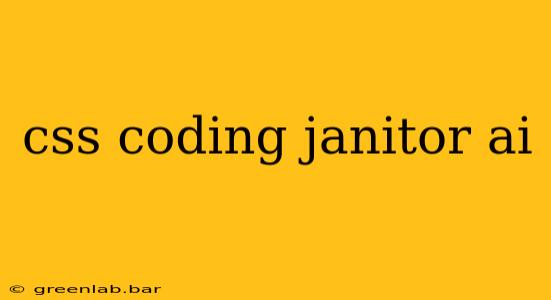The web is a chaotic place. Untamed CSS can quickly turn a sleek website into a sluggish mess. But fear not, fellow developers! This isn't a call to abandon your stylistic ambitions. Instead, it's a call to embrace the power of CSS Coding Janitor AI, a conceptual approach to streamlining your CSS and boosting website performance. Think of it as your dedicated digital cleanup crew for your stylesheets.
What is CSS Coding Janitor AI?
CSS Coding Janitor AI isn't a specific software or tool (yet!). It's a methodology, a mindset. It's about bringing a methodical, automated approach to cleaning up your CSS code, leveraging tools and techniques that mirror the work of a meticulous janitor. Just as a janitor keeps a building clean and efficient, a "CSS Coding Janitor" keeps your CSS lean, mean, and optimized.
This involves several key practices:
1. Dead Code Removal: The Trash Compactor
Every project accumulates unused CSS. Functions, classes, and styles that were once relevant might now be obsolete. A CSS Coding Janitor AI approach would involve aggressively identifying and removing this dead weight. This can be achieved through:
- Automated tools: Several linters and analysis tools can flag unused CSS selectors, saving you the manual effort.
- Regular audits: Schedule regular reviews of your CSS to identify and remove any redundant or unused code.
2. Code Consolidation: The Efficient Organizer
Unorganized CSS is a nightmare to maintain and debug. A janitor wouldn't leave tools scattered; similarly, your CSS should be neatly arranged and consolidated. This includes:
- Using CSS preprocessors: Sass or Less help you organize your code into modules and mixins, making it easier to manage and maintain.
- Employing a consistent naming convention: A logical naming system for classes and IDs makes your CSS more readable and maintainable.
- Refactoring repetitive code: Identify and consolidate repeated styles into reusable classes or mixins.
3. Optimization for Performance: The Speed Demon
Inefficient CSS can significantly impact your website's loading speed. A CSS Coding Janitor AI approach would prioritize optimization techniques like:
- Minification: Removing unnecessary whitespace and comments reduces the file size of your CSS, speeding up load times.
- Compression: Using gzip or Brotli compression further reduces the size of your CSS files.
- Efficient selectors: Avoid overly complex selectors and use more specific selectors to improve rendering performance.
- Inlining critical CSS: Inline the CSS needed for above-the-fold content to improve the initial page load time.
4. Maintainability: The Preventative Measures
A clean workspace is easier to maintain. Similarly, well-organized and efficient CSS requires less maintenance in the long run. This involves:
- Version control: Use Git or a similar version control system to track changes and revert to previous versions if needed.
- Regular code reviews: Have other developers review your CSS code to catch potential issues and ensure consistency.
- Automated testing: Implement automated tests to catch errors and ensure your CSS is working as expected.
The Future of CSS Coding Janitor AI
While not a single, readily available AI tool today, the concept is increasingly feasible. Future iterations of CSS linters, automated code-refactoring tools, and AI-powered performance analysis could automate many of these tasks, making the "CSS Coding Janitor AI" a reality. This future will allow developers to focus on creative design rather than tedious cleanup, resulting in better websites and improved developer workflows. The journey towards this future involves embracing best practices today. Start cleaning up your CSS now, and you'll thank yourself later.

